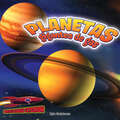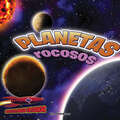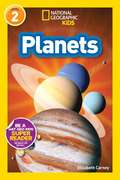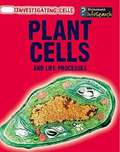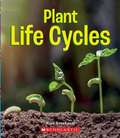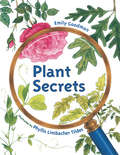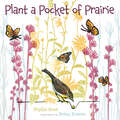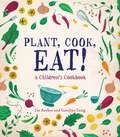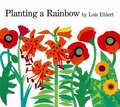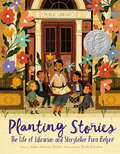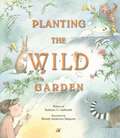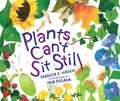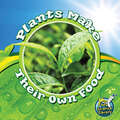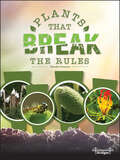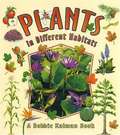- Table View
- List View
Planetas gigantes de gas: Giant Gas Planets: Jupiter, Saturn, Uranus, and Neptune (Inside Outer Space)
by Kyla SteinkrausThe four planets farthest from the Sun are called the gas giants. Jupiter, Saturn, Uranus, and Neptune are different from the other planets in our solar system. They are not solid, but are made of liquids and clouds of gas with gravity pulling it all together into a planet shape. Learn facts about the climate, gases, size, and other quirky things each of the planets possess. This book isn’t filled with hot air! Pull out your telescope and see if you can observe one of these planets. This book will allow students to understand that patterns in the natural world can be observed, used to describe phenomena, and used as evidence.
Planetas rocosos: Rocky Planets: Mercury, Venus, Earth, and Mars (Inside Outer Space)
by Kyla SteinkrausOur solar system is made up of the millions of objects in the sky above us, including the Sun, moon, stars, and planets. This book examines the four planets closest to the Sun, known as the rocky planets. All four planets, Mercury, Venus, Earth, and Mars are described with information about their atmosphere, landscape, orbits, and Fun Facts that give additional information about each of these rocky planets! This book will allow students to use observations of the Sun, moon, and stars to describe patterns that can be predicted.
Planets (National Geographic Kids Readers #Level 2)
by Elizabeth Carney Laura MarshThis brilliantly illustrated book taps into children's natural curiosity about the vast world of space. This level two reader, written in simple language that is easy for young readers to understand, introduces children to our solar system, including all of the planets and dwarf planets, and lots of fascinating fun facts. <P><P>This reader helps cultivate the explorers of tomorrow! This high-interest, educationally vetted series of beginning readers features the magnificent images of National Geographic, accompanied by texts written by experienced, skilled children's book authors. The inside back cover of the paperback edition is an interactive feature based upon the book. <P><P> Level 1 books reinforce the content of the book with a kinesthetic learning activity. In Level 2 books readers complete a Cloze letter, or fun fill-in, with vocabulary words.
Plant Cells And Life Processes
by Barbara A. SomervillThis book explores the features of the plant cell and their life processes.
Plant Growth and Development: Student Investigations
by National Science Resources CenterNIMAC-sourced textbook
Plant Life Cycles (A True Book)
by Mara GrunbaumIncredible Plants series introduces young investigative readers to many types of unusual and typical plants from photosynthesis, how they grow, and ways they survive in extreme environments.
Plant Secrets
by Emily GoodmanYoung scientists will love this nature mystery that reveals the secrets hiding in seeds, plants, flowers, and fruits throughout the life cycle of various flora. Curiosity will bloom in this introduction to botany and primary nature science. Plants come in all shapes and sizes, but they go through the same stages as they grow. Using four common plants, young readers learn about plant structure and life cycle. Simple text and colorful, detailed illustrations show the major phases of plant growth with each stage holding a &“secret&” for curious readers to guess. Back matter offers more information on each plant, as well as greater detail on each stage of growth.
Plant a Kiss
by Amy Krouse RosenthalFrom the beloved New York Times bestselling author of Dear Girl, Amy Krouse Rosenthal, a simple and timeless celebration of the power of love.Little Miss planted a kiss...One small act of love blooms into something bigger and more dazzling than Little Miss could have ever imagined in this epic journey about life, kindness, and giving.Amy Krouse Rosenthal and Peter H. Reynolds team together to share a message of hope and to remind us all of the joys to be gained from being open and unselfish.Plant a Kiss works to spark the imagination of the youngest readers, but it will also resonate with anyone, such as a new graduate, who responds to the power of planting a kiss.
Plant a Pocket of Prairie
by Phyllis RootAuthor Phyllis Root and illustrator Betsy Bowen last explored the vast, boggy peatlands of northern Minnesota in their book Big Belching Bog. Now, in Plant a Pocket of Prairie, Root and Bowen take young readers on a trip to another of Minnesota&’s important ecosystems: the prairie. Once covering almost 40 percent of the United States, native prairie is today one of the most endangered ecosystems in the world. Plant a Pocket of Prairie teaches children how changes in one part of the system affect every other part: when prairie plants are destroyed, the animals who eat those plants and live on or around them are harmed as well. Root shows what happens when we work to restore the prairies, encouraging readers to &“plant a pocket of prairie&” in their own backyards. By growing native prairie plants, children can help re-create food and habitat for the many birds, butterflies, and other animals that depend on them. &“Plant cup plants,&” Root suggests. &“A thirsty chickadee might come to drink from a tiny leaf pool. Plant goldenrod. A Great Plains toad might flick its tongue at goldenrod soldier beetles.&” An easy explanation of the history of the prairie, its endangered status, and how to go about growing prairie plants follows, as well as brief descriptions of all the plants and animals mentioned in the story. With Betsy Bowen&’s beautiful, airy illustrations capturing the feel of an open prairie and all its inhabitants, readers of all ages will be inspired to start planting seeds and watching for the many fascinating animals their plants attract. What a marvelous transformation could take place if we all planted a pocket of prairie!
Plant, Cook, Eat!: A Children's Cookbook
by Caroline Craig Joe ArcherFor beginners and green-thumbed foodies, this unusually all-inclusive garden-to-kitchen cookbook is part lesson in gardening and part collection of healthy, delicious, kid-friendly recipes.With vibrant photo-illustrations and clearly organized sections, discover how to plant seeds in patio containers, window boxes, or on an allotment; harvest fruits and vegetables; determine which plant parts are edible; spot pests in the garden; and use home-grown crops to cook everything from bean and bacon spaghetti to polenta chips to tomato, feta, and basil pizza."This effort offers budding young gardeners (and their adults) a comprehensive, hands-on guide to gardening and cooking" — Kirkus Reviews STARRED REVIEW
Planting A Rainbow
by Lois EhlertThis educational and enjoyable book helps children understand how to plant bulbs, seeds, and seedlings, and nurture their growth. Lois Ehlert's bold collage illustrations include six pages of staggered width, presenting all the flowers of each color of the rainbow.
Planting Stories: The Life of Librarian and Storyteller Pura Belpré
by Anika Aldamuy DeniseRECIPIENT OF THE PURA BELPRÉ HONOR * A Today Show's Best Kids' Books of 2019 * Indie Next List Pick * Junior Library Guild Selection * “An appealing tribute and successful remedy to the lack of titles about the groundbreaking librarian...a must-have for all libraries.” —School Library Journal (starred review)An inspiring picture book biography of storyteller, puppeteer, and New York City’s first Puerto Rican librarian, who championed bilingual literature.When she came to America in 1921, Pura Belpré carried the cuentos folklóricos of her Puerto Rican homeland. Finding a new home at the New York Public Library as a bilingual assistant, she turned her popular retellings into libros and spread story seeds across the land. Today, these seeds have grown into a lush landscape as generations of children and storytellers continue to share her tales and celebrate Pura’s legacy.Brought to colorful life by Paola Escobar’s elegant and exuberant illustrations and Anika Aldamuy Denise’s lyrical text, this gorgeous book is perfect for the pioneers in your life.Informative backmatter and suggested further reading included.A Spanish-language edition, Sembrando historias: Pura Belpré: bibliotecaria y narradora de cuentos, is also available.“Anika Aldamuy Denise’s intimate telling captures the magical, folk-tale feeling of Belpré’s own stories. Her lyrical text, sprinkled like fairy dust with Spanish words, begs to be read aloud, while Paola Escobar’s stylishly detailed and warmly expressive illustrations capture the joy of sharing stories.” —New York Times Book Review
Planting a Rainbow (Fountas & Pinnell LLI Blue #Level F)
by Lois EhlertA mother and child plant a rainbow of flowers in the family garden.
Planting a Rainbow (Fountas & Pinnell LLI Blue: Level F)
by Lois EhlertThis educational and enjoyable book helps children understand how to plant bulbs, seeds, and seedlings, and nurture their growth. Lois Ehlert's bold collage illustrations include six pages that present all the flowers of each color of the rainbow.
Plants Can't Sit Still
by Mia Posada Rebecca E. HirschDo plants really move? Absolutely! You might be surprised by all ways plants can move. Plants might not pick up their roots and walk away, but they definitely don't sit still! Discover the many ways plants (and their seeds) move. Whether it's a sunflower, a Venus flytrap, or an exotic plant like an exploding cucumber, this fascinating picture book shows just how excitingly active plants really are.
Plants Make Their Own Food (My Science Library)
by Julie LundgrenIntermediate Readers Learn About Photosynthesis.
Plants That Break the Rules (Nature's Rule Breakers)
by VizcarraNot all plants behave like plants. Did you know that some plants eat animals, and only sprout only after catching on fire? These plants are some of the weirdest but coolest plants in nature, and they're all inside this kids book about plant behavior. Why are they like this? Be a plant detective and find out in the Plants That Break the Rules Plant Book! Part of the Nature’s Rule Breaker’s Children’s Book Series, this 32-page nonfiction book explores weird but cool plant species that don't follow the rules of nature with fun-filled facts and vibrant photos that will prove just how unique these plants really are!Science Books for Kids Ages 8-12 Features:Comprehension questionsExtension activitySupports NGSS standardsAbout Rourke Educational Media:We proudly publish respectful and relevant nonfiction and fiction titles that represent our diverse readers, and are designed to support reading on a level that has no limits!
Plants and Animals (Delta Science Modules)
by Lawrence Hall of Science University of California at Berkeley Delta EducationNIMAC-sourced textbook
Plants in Different Habitats
by Bobbie Kalman Rebecca SjongerPlants are living things that grow and change. Over time, plants have made remarkable adaptations to suit the habitats in which they live. Simple text and beautiful images highlight how plants have adapted to life in the Arctic, in aquatic environments, and in other habitats such as those in deserts and grasslands.
